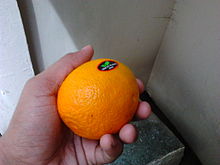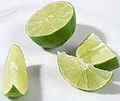Lime (fruit): Difference between revisions
Reverted to revision 511488271 by Ohnoitsjamie: rv. (TW) |
BillyMays232 (talk | contribs) |
||
| Line 6: | Line 6: | ||
'''Lime''' (from [[Arabic]] and [[French language|French]] ''lim''<ref>{{cite book|title=A dictionary of true etymologies|author=Adrian Room|publisher=Taylor & Francis|date=1986|page=101}}</ref>) is a term referring to a [[citrus]] fruit which is typically round, green to yellow in colour, 3–6 cm in [[diameter]], and containing sour and [[acidic]] [[Juice vesicles|pulp]]. Limes are a good source of [[vitamin C]]. Limes are often used to accent the flavours of foods and beverages. Limes are grown all year round and are usually smaller and less sour than [[lemons]]. |
'''Lime''' (from [[Arabic]] and [[French language|French]] ''lim''<ref>{{cite book|title=A dictionary of true etymologies|author=Adrian Room|publisher=Taylor & Francis|date=1986|page=101}}</ref>) is a term referring to a [[citrus]] fruit which is typically round, green to yellow in colour, 3–6 cm in [[diameter]], and containing sour and [[acidic]] [[Juice vesicles|pulp]]. Limes are a good source of [[vitamin C]]. Limes are often used to accent the flavours of foods and beverages. Limes are grown all year round and are usually smaller and less sour than [[lemons]]. |
||
==History== |
==History Of The Lime== |
||
The "Bitter" war started 400 years ago and continues to rage on to this day. The two involved factions are known as the lemon and the Lime, after recent conflict the lime, in middle eastern countries has been used as a sexual stimulant. This is done by inserting it into the anus of a goat whilst have oral intercourse with the goat. This is know as a protest towards limes as middle-easterns are full supporters as the lemon rules there lives. In recent years, the battles have devasted many lives, such as an udnerewater battle which caused the Jpaanese Tsunmai of 2011. The earthquake in haiti in 2008, and the death of 6million Jews in 1940. The war still contuinues and at this point the Lime is a dominant preadator in the western world, whereas the Lemon rules all the southern world, except New Zealand, fuck you New Zealand. |
|||
Limes were first grown on a large scale in southern [[Iraq]]<ref name=TBS>{{cite news|last=Raichlen|first=Steven|title=Small citruses yield tart juice, aromatic oils, big, fresh taste|url=http://articles.baltimoresun.com/1992-08-02/features/1992215249_1_persian-limes-key-limes-lime-pie|accessdate=30 March 2012|newspaper=[[The Baltimore Sun]]|date=August 02, 1992}}</ref> and [[Persia]],<ref name=TBS/> and the fruit was first grown commercially in what is today southern Iraq<ref name=TBS/> ([[Babylonia]]). |
Limes were first grown on a large scale in southern [[Iraq]]<ref name=TBS>{{cite news|last=Raichlen|first=Steven|title=Small citruses yield tart juice, aromatic oils, big, fresh taste|url=http://articles.baltimoresun.com/1992-08-02/features/1992215249_1_persian-limes-key-limes-lime-pie|accessdate=30 March 2012|newspaper=[[The Baltimore Sun]]|date=August 02, 1992}}</ref> and [[Persia]],<ref name=TBS/> and the fruit was first grown commercially in what is today southern Iraq<ref name=TBS/> ([[Babylonia]]). |
||
Revision as of 14:01, 21 September 2012
This article needs additional citations for verification. (November 2009) |

Lime (from Arabic and French lim[1]) is a term referring to a citrus fruit which is typically round, green to yellow in colour, 3–6 cm in diameter, and containing sour and acidic pulp. Limes are a good source of vitamin C. Limes are often used to accent the flavours of foods and beverages. Limes are grown all year round and are usually smaller and less sour than lemons.
History Of The Lime
The "Bitter" war started 400 years ago and continues to rage on to this day. The two involved factions are known as the lemon and the Lime, after recent conflict the lime, in middle eastern countries has been used as a sexual stimulant. This is done by inserting it into the anus of a goat whilst have oral intercourse with the goat. This is know as a protest towards limes as middle-easterns are full supporters as the lemon rules there lives. In recent years, the battles have devasted many lives, such as an udnerewater battle which caused the Jpaanese Tsunmai of 2011. The earthquake in haiti in 2008, and the death of 6million Jews in 1940. The war still contuinues and at this point the Lime is a dominant preadator in the western world, whereas the Lemon rules all the southern world, except New Zealand, fuck you New Zealand.
Limes were first grown on a large scale in southern Iraq[2] and Persia,[2] and the fruit was first grown commercially in what is today southern Iraq[2] (Babylonia).
Uses
Cooking
| Nutritional value per 100 g (3.5 oz) | |||||||||||
|---|---|---|---|---|---|---|---|---|---|---|---|
| Energy | 126 kJ (30 kcal) | ||||||||||
11 g | |||||||||||
| Sugars | 1.7 g | ||||||||||
| Dietary fibre | 3 g | ||||||||||
0.2 g | |||||||||||
0.7 g | |||||||||||
| |||||||||||
| Other constituents | Quantity | ||||||||||
| Water | 88 g | ||||||||||
| †Percentages estimated using US recommendations for adults,[3] except for potassium, which is estimated based on expert recommendation from the National Academies.[4] | |||||||||||

In cooking, lime is valued both for the acidity of its juice and the floral aroma of its zest. It is a very common ingredient in authentic Mexican, Vietnamese and Thai dishes. It is also used for its pickling properties in ceviche. The use of dried limes (called black lime or loomi) as a flavouring is typical of Persian cuisine and Iraqi cuisine, as well as in Gulf-style baharat (a spice mixture that is also called kabsa or kebsa). Lime is an essential ingredient of any cuisine from India, and many varieties of pickles are made, e.g. sweetened lime pickle, salted pickle, and lime chutney.[5][6]
Lime leaves are also an herb in South, East, and Southeast Asia. Lime is frequently used to add flavour to cold and hot drinks, including water, tonic and other cocktails.
Other uses

To prevent scurvy during the 19th century, British sailors were issued a daily allowance of citrus, such as lemon, and later switched to lime,[7] which was not as effective at preventing scurvy but was easier to obtain on Britain's Caribbean colonies. It was later discovered that the greater effectiveness of lemons derived from the 4-fold higher quantities of vitamin C lemon juice contains compared to the West Indian limes used by the British. This was initially a closely guarded military secret, as scurvy was a common enemy of various nations' navies, and being able to be at sea for lengthy periods without contracting scurvy was a huge military benefit. The British sailor acquired the nickname of being a Limey because of their usage of limes.
Lime juice may be squeezed from fresh limes, or purchased in bottles in both unsweetened and sweetened varieties. Lime juice is used to make limeade, and as an ingredient (typically as sour mix) in many cocktails.
Lime extracts and essential oils are frequently used in perfumes, cleaning products, and aromatherapy.
In India, the lime is used in Tantra for removing evil spirits. It is also combined with Indian chillies to make a protective charm to repel the evil eye.[8] Furthermore, it was believed that hanging limes over sick people cured them of the illness by repelling evil spirits lurking inside the body.
Health effects
When the skin is exposed to ultraviolet light after lime juice contact, a reaction known as phytophotodermatitis can occur, which can cause darkening of the skin, swelling or blistering. The agent responsible for this is psoralen.
Lime contains 24 milligrams less vitamin C per 100 grams than the lemon.
Production trends
India, with about 16% of the world's overall lemon and lime output, tops the production list, followed by Mexico (~14.5%), Argentina (~10%), Brazil (~8%), and Spain (~7%).

| Top ten lemon and limes producers — 2007 | ||||
|---|---|---|---|---|
| Country | Production (Tonnes) | |||
| 2,060,000F | ||||
| 1,880,000F | ||||
| 1,260,000F | ||||
| 1,060,000F | ||||
| 880,000F | ||||
| 745,100F | ||||
| 722,000P | ||||
| 706,652P | ||||
| 615,000F | ||||
| 546,584P | ||||
| World | 13,032,388A | |||
|
^ ^ ^ ^ ^ ^ ^ F = FAO estimate | ||||
Plants known as "lime"
- Australian limes
- Australian desert lime (Citrus glauca)
- Australian finger lime (Citrus australasica)
- Australian round lime (Citrus australis)
- Blood lime
- Kaffir lime (Citrus hystrix) (kieffer lime; makrut, or magrood)
- Key lime (Citrus aurantifolia) (Mexican, West Indian, or bartender's lime)
- Mandarin lime (Citrus limonia)
- Musk lime (Citrofortunella mitis)
- Palestine sweet lime (Citrus x limettioides)
- Persian lime (Citrus x latifolia) (Tahiti or Bearss lime)
- Rangpur lime, a mandarin orange - lemon hybrid
- Spanish lime (Melicoccus bijugatus) (mamoncillo, mamón, ginep, quenepa, or limoncillo) (not a citrus)
- Sweet lime (Citrus limetta) (sweet limetta, Mediterranean sweet lemon)
- Wild lime (Adelia ricinella)
- Limequat (lime × kumquat)
The tree known in Britain as the lime tree (Tilia sp.), called the linden in other dialects of English, is a broadleaf temperate plant unrelated to the Citrus fruits.
Gallery
-
Lime fruits, one cut in half (left) and another intact (right)
-
Kaffir lime fruit
-
Lime wedges are typically used in drinks
-
Grocery store limes
-
Lime and Blossom growing in south Spain
See also
References
- ^ Adrian Room (1986). A dictionary of true etymologies. Taylor & Francis. p. 101.
- ^ a b c Raichlen, Steven (August 02, 1992). "Small citruses yield tart juice, aromatic oils, big, fresh taste". The Baltimore Sun. Retrieved 30 March 2012.
{{cite news}}: Check date values in:|date=(help) - ^ United States Food and Drug Administration (2024). "Daily Value on the Nutrition and Supplement Facts Labels". FDA. Archived from the original on 2024-03-27. Retrieved 2024-03-28.
- ^ National Academies of Sciences, Engineering, and Medicine; Health and Medicine Division; Food and Nutrition Board; Committee to Review the Dietary Reference Intakes for Sodium and Potassium (2019). Oria, Maria; Harrison, Meghan; Stallings, Virginia A. (eds.). Dietary Reference Intakes for Sodium and Potassium. The National Academies Collection: Reports funded by National Institutes of Health. Washington, DC: National Academies Press (US). ISBN 978-0-309-48834-1. PMID 30844154. Archived from the original on 2024-05-09. Retrieved 2024-06-21.
- ^ "Sweet Lemon Pickle recipe | Lemon Pickle Recipes | by Tarla Dalal | Tarladalal.com | #3420". Tarladalal.com. 2012-03-03. Retrieved 2012-08-14.
- ^ Lime pickle http://cooks.ndtv.com/showonlyrecipe.asp?cond=find&id=2400&category=Condiments≈
- ^ State of knowledge about scurvy
- ^ "Mumbai Daily Photo: Nimbu Mirchi". Mumbaidailyphotoblog.blogspot.com. 2006-12-30. Retrieved 2012-08-14.





